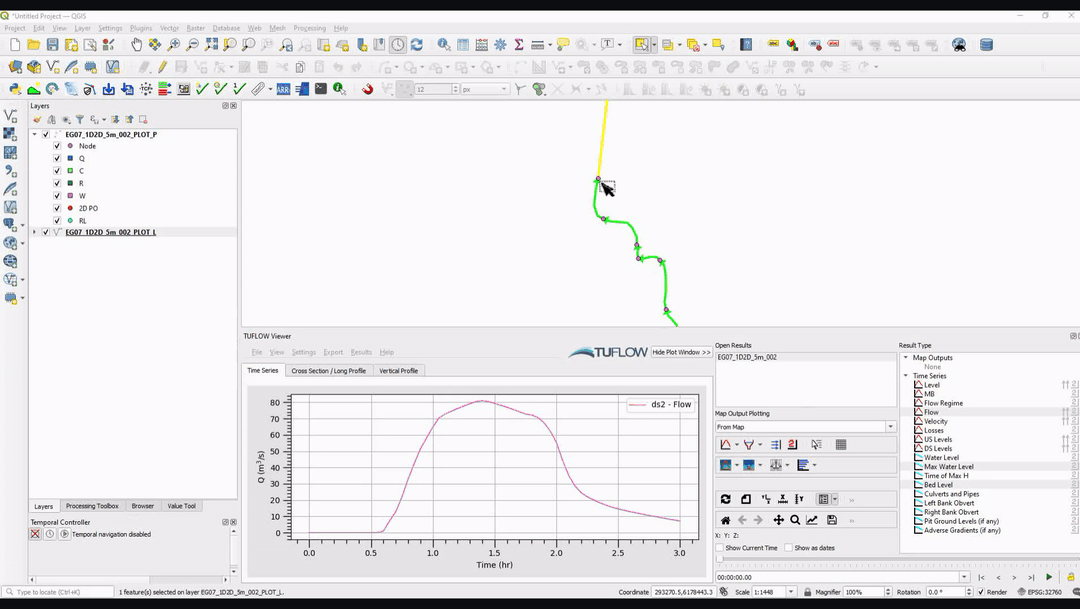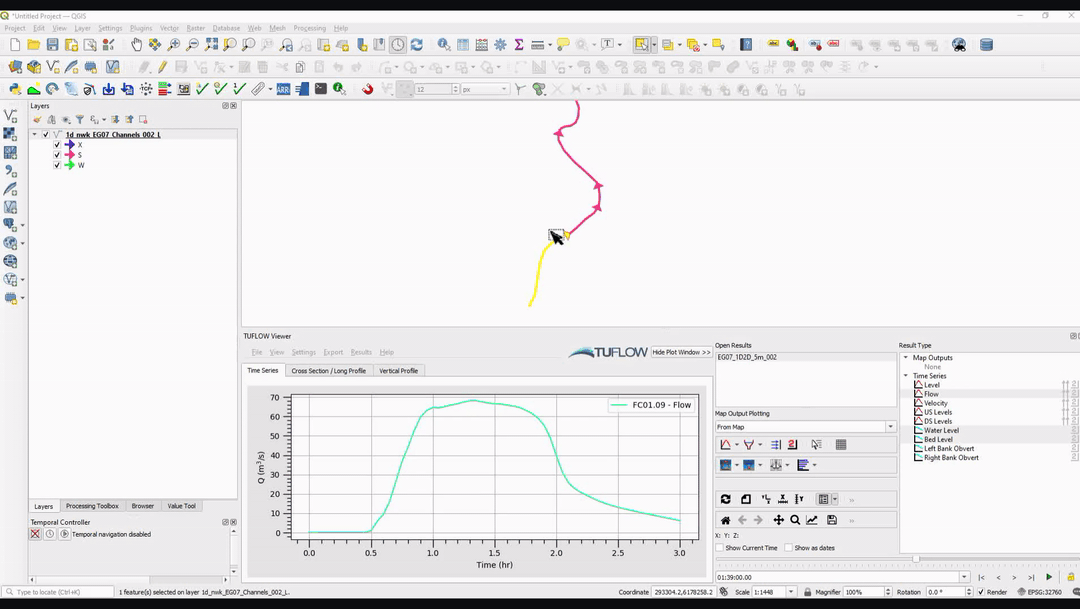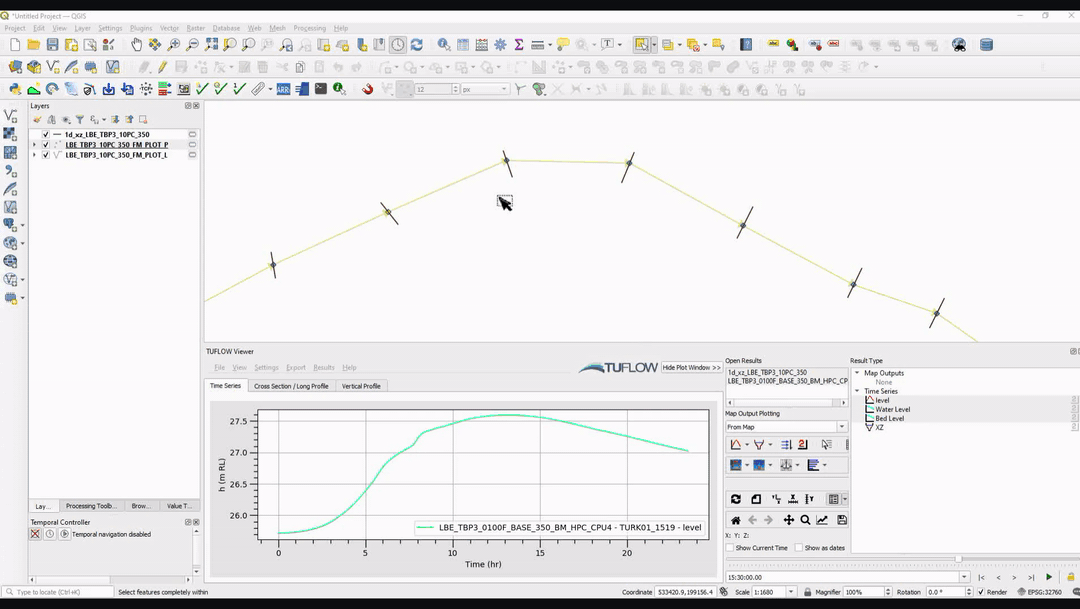TUFLOW Viewer - Time Series Outputs GIS Data
TUFLOW / ESTRY 2016 or Newer
From the 2016 TUFLOW release, time series outputs are written by TUFLOW into the 2D result location in a folder named "plot" (TUFLOW\results\2D\plot). This folder consists of subfolders called "csv" and "gis" and they contain the result information imported into TUFLOW Viewer. This information can be viewed by the user in other programs (e.g. MS Excel), meaning TUFLOW Viewer is not required to view these results. However, TUFLOW Viewer offers a quick and convenient way of viewing and interacting with the results in your QGIS workspace. It also offers:
- Additional processing, such as plotting long profiles, that are not in a ready to plot format straight out of TUFLOW.
- The unique functionality of dynamically viewing the map output results in conjunction with the time series results.
Since the 2018 TUFLOW release, a NetCDF output format is offered for time series results, either instead of csv, or as well as csv. The NetCDF format is a useful format as it contains all of the information in a single compressed file (as opposed to multiple csv files). TUFLOW Viewer will be able to load the NetCDF output and there will not be any loss in functionality if this format is used.
Also in the "plot" folder is an output file with the extension *.tpc. This is the TUFLOW Plot Control and is the file loaded into TUFLOW Viewer. This file contains information on the location of the outputs and is a plain text file that users can inspect if they wish.
Key to the time series results are the GIS layers located in the "plot/gis" folder. There will be three vector files:
- _PLOT_P - point layer
- _PLOT_L - line layer
- _PLOT_R - region (polygon) layer
The users will interact with these layers (select them in QGIS) to plot results from different elements. The layer you need to interact with will be dependent on the result type. For example, for the majority of instances, "water level" results will require the user to select point features in the _PLOT_P. Another example, plotting flow through a culvert will require the user to select the culvert feature in the _PLOT_L layer.
Example
| Up |
|---|
TUFLOW / ESTRY 2013 or Older
If you have results from the 2013 TUFLOW release, you won't have the ability to load the *.tpc file as this was introduced in the 2016 TUFLOW release. TUFLOW Viewer does support time series results from the 2013 release, and is loaded from the *.info file in the 1D result folder in a subfolder called "csv". This information can be viewed by the user in other programs (e.g. MS Excel), meaning TUFLOW Viewer is not required to view these results. However, TUFLOW Viewer offers a quick and convenient way of viewing and interacting the results in your QGIS workspace. It also offers:
- Additional processing such as plotting long profiles that are not necessarily in a ready to plot format straight out of TUFLOW.
- The unique functionality of dynamically viewing the map output results in conjunction with the time series results.
The *.info file contains information on the location of the outputs and is a plain text file that users can inspect if they wish. The difference between the *.info file from the 2013 release and the *.tpc from the 2016 release (and onward) is that the *.info contains information on the 1D time series results only i.e. does not contain 2D time series information (plot outputs or reporting locations). It also does not contain any maximum data from the time series results.
To plot the results, users will need to open the relevant 1d_nwk GIS files and select features in QGIS. This differs from the *.tpc as this will output special GIS layers used for plotting and TUFLOW Viewer will open these automatically. These are also consolidated into three GIS files (depending solely on the geometry of the layer). Using the *.info approach, users will need to open all desired input files (which can be numerous for bigger models).
For more information on plotting from time series outputs, see the link below on plotting.
Example
| Up |
|---|
Flood Modeller
Flood Modeller time series results can be imported into TUFLOW Viewer using the "Load Results - Time Series FM" option. For more information on the files required, please see Load Results - Time Series FM.
Key to the time series results are the GIS layers created when the user imports FM results. There will be two vector files:
- _FM_PLOT_P - point layer
- _FM_PLOT_L - line layer
These layers are similar to the GIS files that are opened when loading ESTRY time series results. Unlike ESTRY, these files do not exist on disk and instead are created in memory (RAM). Therefore, these files will be deleted if QGIS is closed. To prevent this, users can save files in QGIS if desired (right click the layer in the Layers Panel and select "export" >> "Save Features As"). The time series results will be shown by selecting features in the point layer (_FM_PLOT_P). Currently TUFLOW Viewer only supports water level, velocity, and flow output types. The line layer (_FM_PLOT_L) is used for longitudinal plots. For more information on plotting results, please see the relevant link in the section below.
During the load process the user can choose to include the cross-section *.dat file which will also generate a cross-section GIS layer (again this is stored in memory (RAM), not on disk). This will enable the cross-sections to be viewed in TUFLOW Viewer and the bed elevation to be plotted for longitudinal profiles.
Example
| Up |
|---|


